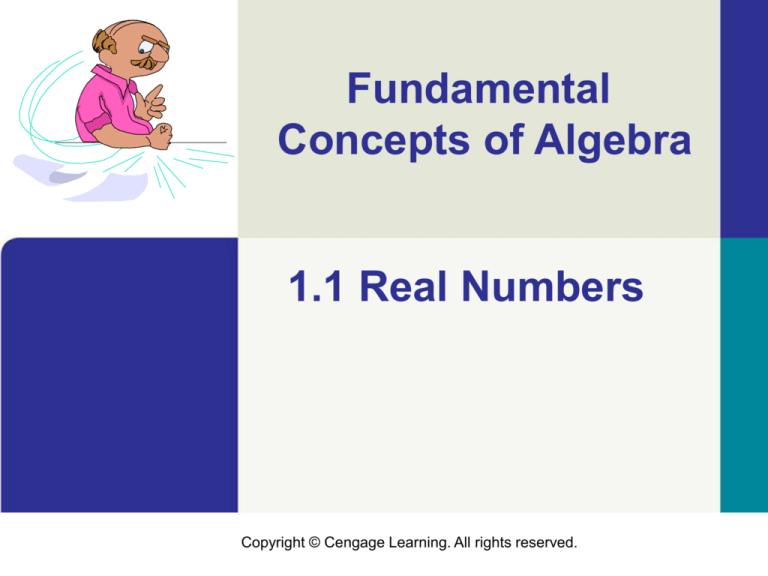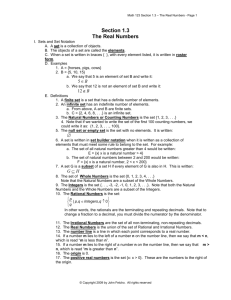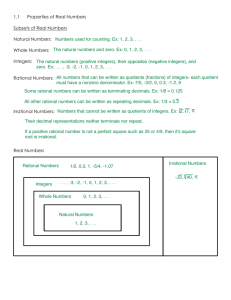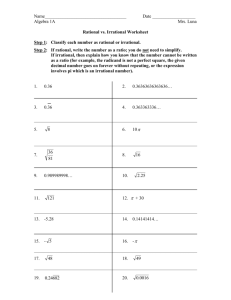
Fundamental
Concepts of Algebra
1.1 Real Numbers
Copyright © Cengage Learning. All rights reserved.
Real Numbers
Real numbers are used throughout mathematics, and you
should be acquainted with symbols that represent them,
such as
1, 73, –5,
0.33333 . . . , 596.25,
and so on.
The positive integers, or natural numbers, are
1, 2, 3, 4, . . . .
2
Real Numbers
The whole numbers (or nonnegative integers) are the
natural numbers combined with the number 0. The
integers are often listed as follows:
. . . , –4, –3, –2, –1, 0, 1, 2, 3, 4, . . .
The lowercase letters a, b, c, x, y, … represent arbitrary
real numbers (also called variables).
If a and b denote the same real number, we write a = b,
which is read “a is equal to b” and is called an equality.
The notation a b is read “a is not equal to b.”
3
Real Numbers
If a, b, and c are integers and c = ab, then a and b are
factors, or divisors, of c. For example, since
6 = 2 3 = (–2)(–3) = 1 6 = (–1)(–6),
we know that 1, –1 , 2, –2, 3, –3, 6, and –6 are factors of 6.
A positive integer p different from 1 is prime if its only
positive factors are 1 and p. The first few primes are 2, 3, 5,
7, 11, 13, 17, and 19.
The Fundamental Theorem of Arithmetic states that
every positive integer different from 1 can be expressed as
a product of primes in one and only one way (except for
order of factors).
4
Real Numbers
Some examples are
12 = 2 2 3 , 126 = 2 3 3 7, 540 = 2 2 3 3 3 5.
A rational number is a real number that can be expressed
in the form a/b, where a and b are integers and b 0. Note
that every integer a is a rational number, since it can be
expressed in the form a/1.
Every real number can be expressed as a decimal, and the
decimal representations for rational numbers are either
terminating or nonterminating and repeating.
5
Real Numbers
For example, we can show by using the arithmetic process
of division that
= 1.25
and
= 3.2181818 . . . ,
where the digits 1 and 8 in the representation of
indefinitely (sometimes written 3.218).
repeat
6
Real Numbers
Real numbers that are not rational are irrational numbers.
Decimal representations for irrational numbers are always
nonterminating and nonrepeating.
One common irrational number, denoted by , is the ratio
of the circumference of a circle to its diameter.
We sometimes use the notation 3.1416 to indicate that
is approximately equal to 3.1416.
7
Real Numbers
There is no rational number b such that b2 = 2, where b2
denotes b b.
However, there is an irrational number, denoted by
(the square root of 2), such that (
)2 = 2
The system of real numbers consists of all rational and
irrational numbers.
8
Real Numbers
Relationships among the types of numbers used in algebra
are illustrated in the diagram in Figure 1, where a line
connecting two rectangles means that the numbers named
in the higher rectangle include those in the lower rectangle.
The complex numbers, contain all real numbers.
Types of numbers used in algebra
Figure 1
9
Real Numbers
The real numbers are closed relative to the operation of
addition (denoted by +); that is, to every pair a, b of real
numbers there corresponds exactly one real number a + b
called the sum of a and b.
The real numbers are also closed relative to
multiplication (denoted by ); that is, to every pair a, b of
real numbers there corresponds exactly one real number
a b (also denoted by ab) called the product of a and b.
10
Real Numbers
Important properties of addition and multiplication of real
numbers are listed in the following chart.
Properties of Real Numbers
11
Real Numbers
cont’d
Since a + (b + c) and (a + b) + c are always equal, we may
use a + b + c to denote this real number. We use abc for
either a(bc) or (ab)c.
12
Real Numbers
Similarly, if four or more real numbers a, b, c, d are added
or multiplied, we may write a + b + c + d for their sum and
abcd for their product, regardless of how the numbers are
grouped or interchanged.
The distributive properties are useful for finding products of
many types of expressions involving sums.
The next example provides one illustration.
13
Example 1 – Using distributive properties
If p, q, r, and s denote real numbers, show that
(p + q)(r + s) = pr + ps + qr + qs.
Solution:
We use both of the distributive properties listed in (9) of the
preceding chart:
(p + q)(r + s) = p(r + s) + q(r + s)
second distributive property,
with c = r + s
= (pr + ps) + (qr + qs)
first distributive property
= pr + ps + qr + qs
remove parentheses
14
Real Numbers
Properties 1 and 2 state that the same number may be
added to both sides of an equality, and both sides of an
equality may be multiplied by the same number.
15
Real Numbers
When we use the word or as we do in (2), we mean that
at least one of the factors a and b is 0. We will refer to (2)
as the zero factor theorem in future work.
Some properties of negatives are listed in the following
chart.
Properties of Negatives
16
Real Numbers
The reciprocal of a nonzero real number a is often
denoted by a–1, as in the next chart.
Notation for Reciprocals
Note that if a ≠ 0, then
17
Real Numbers
The operations of subtraction (–) and division () are
defined as follows.
Subtraction and Division
18
Real Numbers
We use either a/b or for
and a b refer to a/b as the
quotient of a and b or the fraction a over b.
The numbers a and b are the numerator and
denominator, respectively, of a/b. Since 0 has no
multiplicative inverse a/b, is not defined if b = 0; that is,
division by zero is not defined. It is for this reason that the
real numbers are not closed relative to division.
Note that
19
Real Numbers
The following properties of quotients are true, provided all
denominators are nonzero real numbers.
Properties of Quotients
20
Real Numbers
cont’d
21
Real Numbers
Real numbers may be represented by points on a line l
such that to each real number a there corresponds exactly
one point on l and to each point P on l there corresponds
one real number. This is called a one-to-one
correspondence.
We first choose an arbitrary point O, called the origin, and
associate with it the real number 0.
22
Real Numbers
Points associated with the integers are then determined by
laying off successive line segments of equal length on
either side of O, as illustrated in Figure 2.
Figure 2
The point corresponding to a rational number, such as
is
obtained by subdividing these line segments. Points
associated with certain irrational numbers, such as
can
be found by construction.
23
Real Numbers
The number a that is associated with a point A on l is the
coordinate of A. We refer to these coordinates as a
coordinate system and call l a coordinate line or a
real line.
A direction can be assigned to l by taking the positive
direction to the right and the negative direction to the left.
The positive direction is noted by placing an arrowhead on
l, as shown in Figure 2.
The numbers that correspond to points to the right of O in
Figure 2 are positive real numbers.
24
Real Numbers
Numbers that correspond to points to the left of O are
negative real numbers. The real number 0 is neither
positive nor negative.
Note the difference between a negative real number and
the negative of a real number. In particular, the negative of
a real number a can be positive.
For example, if a is negative, say a = –3, then the negative
of a is –a = –(–3) = 3, which is positive. In general, we have
the following relationships.
25
Real Numbers
In the following chart we define the notions of greater than
and less than for real numbers a and b. The symbols >
and < are inequality signs, and the expressions a > b and
a < b are called (strict) inequalities.
Greater Than or Less Than
26
Real Numbers
If points A and B on a coordinate line have coordinates
a and b, respectively, then a > b is equivalent to the
statement “A is to the right of B,” whereas a < b is
equivalent to “A is to the left of B.”
Illustration: Greater Than (>) and Less Than (<)
• 5 > 3, since 5 – 3 = 2 is positive.
• –6 < –2, since –6 – (–2) = –6 + 2 = –4 is negative.
27
Real Numbers
The next law enables us to compare, or order, any two real
numbers.
We refer to the sign of a real number as positive if the
number is positive, or negative if the number is negative.
Two real numbers have the same sign if both are positive
or both are negative.
28
Real Numbers
The numbers have opposite signs if one is positive and the
other is negative.
The following results about the signs of products and
quotients of two real numbers a and b can be proved using
properties of negatives and quotients.
29
Real Numbers
The converses of the laws of signs are also true. For
example, if a quotient is negative, then the numerator and
denominator have opposite signs.
The notation a b, read “a is greater than or equal to b,”
means that either a > b or a = b (but not both). For
example, a2 0 for every real number a. The symbol
a b, which is read “a is less than or equal to b,” means
that either a < b or a = b.
Expressions of the form a b and a b are called
nonstrict inequalities, since a may be equal to b.
30
Real Numbers
As with the equality symbol, we may negate any inequality
symbol by putting a slash through it— that is >, means not
greater than.
An expression of the form a < b < c is called a continued
inequality and means that both a < b and b < c; we say
“b is between a and c.”
Similarly, the expression c > b > a means that both c > b
and b > a.
31
Real Numbers
Illustration: Ordering Three Real Numbers
•1<5<
• –4 <
<
• 3 > –6 > –10
There are other types of inequalities. For example,
a < b c means both a < b and b c. Similarly, a b < c
means both a b and b < c. Finally, a b c means both
a b and b c.
32
Example 3 – Determining the sign of a real number
If x > 0 and y < 0, determine the sign of
Solution:
Since x is a positive number and y is a negative number,
x and y have opposite signs. Thus, both x/y and y/x are
negative.
The sum of two negative numbers is a negative number, so
the sign of
is negative.
33
Real Numbers
Since a is negative in part (2) of the definition –a,
represents a positive real number.
34
Real Numbers
Some special cases of this definition are given in the
following illustration.
Illustration: The Absolute Value Notation |a|
• |3| = 3, since 3 > 0.
• |–3| = –(–3), since –3 < 0.Thus |–3| = 3.
In the preceding illustration |3| = |–3|.
In general, we have the following:
|a| = |–a|, for every real number a
35
Example 4 – Removing an absolute value symbol
If x < 1, rewrite |x – 1| without using the absolute value
symbol.
Solution:
If x < 1, then x – 1 < 0; that is, x – 1 is negative. Hence, by
part (2) of the definition of absolute value,
|x – 1| = –(x – 1) = –x + 1 = 1 – x.
36
Real Numbers
The number d(A, B) is the length of the line segment AB.
Since d(B, A) = |a – b| and |b – a| = |a – b|, we see that
d(A, B) = d(B, A)
37
Real Numbers
Note that the distance between the origin O and the point A
is
d(O, A) = |a – 0| = |a|,
which agrees with the geometric interpretation of absolute
value illustrated in Figure 4.
The formula d(A, B) = |b – a| is true regardless of the signs
of a and b, as illustrated in the next example.
Figure 4
38
Example 5 – Finding distances between points
Let A, B, C, and D have coordinates –5, –3, 1, and 6,
respectively, on a coordinate line, as shown in Figure 5.
Find d(A, B), d(C, B), d(O, A), and d(C, D).
Figure 5
Solution:
Using the definition of the distance between points on a
coordinate line, we obtain the distances:
d(A, B) = | –3 – (–5)|
= |–3 + | 5|
= |2|
39
Example 5 – Solution
cont’d
= 2
d(C, B) = |–3 – 1|
= |–4|
=4
d(O, A) = |–5 – 0|
= |–5|
=5
d(C, D) = |6 – 1|
= |5|
=5
40
Real Numbers
In the sciences it is often necessary to work with very large
or very small numbers and to compare the relative
magnitudes of very large or very small quantities.
We usually represent a large or small positive number a in
scientific form, using the symbol to denote multiplication.
The distance a ray of light travels in one year is
approximately 5,900,000,000,000 miles. This number may
be written in scientific form as 5.9 1012.
41
Real Numbers
The positive exponent 12 indicates that the decimal point
should be moved 12 places to the right. The notation works
equally well for small numbers.
Illustration: Scientific Form
• 513 = 5.13 102
• 93,000,000 = 9.3 107
42
Real Numbers
If a number a is written in scientific form as a = c 10n for
1 c < 10 and if c is rounded off to k decimal places, then
we say that a is accurate (or has been rounded off) to k + 1
significant figures, or digits.
For example, 37.2638 rounded to 5 significant figures is
3.7264 101, or 37.264; to 3 significant figures, 3.73 101,
or 37.3; and to 1 significant figure, 4 101, or 40.
43









